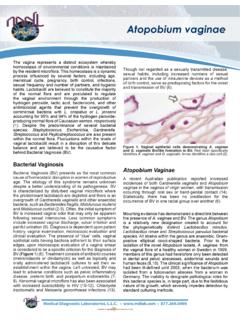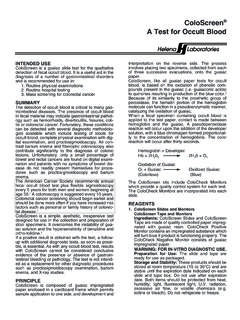Transcription of In vitro diagnostic reagent, calibrator and control ...
1 In vitro diagnostic reagent, calibrator and control material stability Pauline Armstrong Randox laboratories , Ltd. Crumlin The stability of in vitro medical diagnostic devices whether they are reagents, calibrators or quality control materials with respect to laboratory accreditation and current international and European quality standards will be discussed in this presentation, which is divided into two main parts. In the first part, stability issues affecting laboratory accreditation will be discussed followed by a review of what current international and European standards have to say about the stability of an in vitro medical diagnostic device whether it is a reagent, a reagent product, a calibrator or a control material. In the second part the general requirements for stability testing and the generation of stability data will be considered. In the draft version of the standard BS-EN 13640 Stability Testing of in vitro diagnostic medical Devices the following definition of stability is offered: stability is "the ability of an in vitro diagnostic reagent, when kept under specified conditions, to retain throughout the shelf life its characteristics and/or performance within limits specified by the manufacturer".
2 There are some important concepts in this definition. Firstly, stability is related to specified storage conditions for example, refrigerated (2 C-8 C), room temperature (15 C-25 C) and indeed frozen ( -20 C). Secondly, stability is related to the characteristics and performance limits established by the manufacturer. Performance limits may include recovery / accuracy, precision, sensitivity etc. Most clinical pathology laboratories purchase their in vitro diagnostic reagents, calibrators and quality control materials from a variety of national and international in vitro medical diagnostic devices manufacturers. The manufacturer, as an integral part of product development determines the stability characteristics of the product. The stability claims are usually quoted on the product labelling. The end user is not therefore required to conduct any type of stability testing. In their Standards for the medical Laboratory, Clinical Pathology Accreditation (UK) Ltd.
3 State that it is essential to have proper management of reagents, calibration and quality control materials and that these materials must be correctly identified with the date of receipt, lot number, first use and expiry. Some automated clinical chemistry analysers such as the Dade-Behring Dimension are now capable of assimilating reagent shelf life information frequently from a barcode label attached to the reagent, calibrator or control . This feature prevents the inadvertent use of product that has passed its quoted expiry date. However, many analysers, for example the COBAS MIRA and the Hitachi 717, cannot identify product shelf life details from the product label and so the responsibility of using only within date product falls on the laboratory staff. Consequently, for laboratory accreditation purposes, procedures must be in place to ensure that only within date product is used. Whilst a wide spectrum of in vitro medical diagnostic devices may be purchased from their manufacturers, not all the reagents, calibrators and controls required are available in this way.
4 Therefore, it is essential for all laboratory staff to understand the concept of stability testing whether or not they are required to put it into practice. Since this symposium is being held specifically to discuss certification and accreditation of laboratories , the question "why does a laboratory require certification or accreditation?" may be asked. The answer in some cases is very simple. In the absence of accreditation the laboratory cannot operate legally to produce, report and offer interpretation of the results obtained from the analysis of a patient's blood or urine sample. Whilst this may be the reality the whole ethos of laboratory accreditation is to ensure the quality of the product or service. In the United Kindom, Clinical Pathology Accreditation (UK) Ltd. state that accreditation is the process by which an organisation gains recognition that its activities and products have a guaranteed high quality. The accreditation of a laboratory usually involves an external audit to assess the ability of the laboratory to provide a service of high quality.
5 How may a service of high quality be defined? ISO 9000:2000 offers the following definition of quality as "the degree to which a set of inherent characteristics fulfils requirements". David Burnett in his book Understanding Accreditation in Laboratory Medicine offers a definition from an anonymous source that is perhaps more pertinent to laboratory medicine, "a blood glucose result measured on the correct specimen, that is accurate, timely and properly interpreted is a quality product or service". By considering this definition and referring to the definition of stability it can be seen how inherent instability or compromised stability (due, for example, to inappropriate storage of the in vitro diagnostic reagent) may prevent delivery of a quality service by an accredited laboratory. To ensure the accuracy and consistency of the results being reported the stability of the in vitro diagnostic reagent is paramount. It is important to appreciate that the in vitro medical diagnostic devices Directive 98/79/EC does not impose any shelf life requirements on an in vitro medical diagnostic device.
6 For example, there is no general statement that all in vitro medical diagnostic devices must have a shelf life of two years. Neither does the International Standard ISO 9001 in either its 1994 or recently released 2000 versions. Nor does the Food and Drug Administration (FDA) in the United States in its 510 (K) Premarket Notification or Premarket Approval Systems of product registration. Rather, the manufacturer or organisation is required to make stability claims for a particular product, including in vitro medical diagnostic devices and to substantiate these claims with stability data. For any in vitro medical diagnostic device that has been declared compliant with the Directive 98/79/EC and is consequently "CE-Marked" details of stability testing and the stability data to substantiate the claims are held in the product technical file. It is recommended that stability assessment studies are carried out with reference to the draft standard BS-EN 13640. So, what types of stability study should be carried out?
7 Shelf life Firstly, determination of reagent shelf life. The manufacturer must establish and inform the customer, of the expiry date of an in vitro diagnostic reagents kit, reagent, calibrator or control . The period of time from the date of manufacture to the expiry date is termed the shelf life. Shelf life may also be defined as the period of the time during which the performance of the product is considered acceptable. Where possible, shelf life should be based on real time testing. This is not always realistic, as instabilities in an in vitro diagnostic reagents are often only detectable after considerable storage under "normal" conditions. Consequently, most manufactures opt to use data derived from accelerated, heat-stressed testing of the product in its final container, in conjunction with their experience gained from similar in vitro diagnostic reagents to place a product on the market. The results from this type of stability testing can be extrapolated to normal storage conditions.
8 If a reagent is placed on the market with stability claims based on accelerated testing these data should be verified by real-time testing. a) Accelerated stability testing Accelerated testing is usually based on exposure of the reagent, calibrator or control to different elevated temperatures, typically, 25 C, 37 C or 40 C depending on the initial storage temperature recommendation (2 C-8 C or 15 C-25 C). Product is stored at the specified elevated temperature for a predefined period of time, typically, 1 week up to 8 weeks. Samples of the product are then removed and tested according to a predefined protocol. Comparison is made to results obtained from reagent stored at the recommended temperature. In addition, the product may be stored under specified conditions until a significant deterioration of the product is seen. The Arrhenius Equation may then be used to predict the shelf life of the product. b) Real-time stability testing For real-time stability testing sufficient test material is stored at the recommended storage temperature in the final reagent container to last through the complete stability study.
9 Where possible, sufficient calibrators and controls should also be stored to allow completion of the study without changing the lot of calibrator or control . If assessing calibrator or control materials sufficient reagent should be stored to minimise lot changes during the stability study. Product is tested at predefined time intervals using a predefined protocol. Results are analysed according to predefined acceptance criteria. Data may be summarised as a Levy-Jennings plot. The study should be completed to the end of the target shelf life but may be continued until significant degradation in performance can be seen. Reconstituted Stability Testing This type of stability testing applies to lyophilised product. The material is reconstituted, stored appropriately and tested at predefined intervals, for example, between 7 and 28 days inclusive using a pedefined test protocol. The results are compared to those obtained with freshly reconstituted material. Conclusions are made using predefined acceptance criteria.
10 On-Board / Open Vial Stability This is the determination of the stability of an in vitro diagnostic reagent after first opening the primary container and may be assessed either on-board a clinical chemistry analyser in the refrigerated compartment or in a refrigerator at 2 C-8 C. In both cases the reagent is stored in the final reagent vial for up to 28 days, being tested after 7, 14, 21, and 28 days storage according to a predefined protocol. A comparison is made to the results obtained with reagents stored in closed bottles at 2 C-8 C at each time point. Conclusions are made using predefined acceptance criteria. Routine stability testing To ensure that commercially available in vitro medical diagnostic devices meet their respective stability claims, manufacturers must assess the stability of reagents selected at random. This type of testing may be termed 'routine stability testing' and the studies are conducted as for 'real-time' stability testing. Verification of the stability of an in vitro diagnostic reagent after modification This type of stability testing is designed to ensure that any modification to an in vitro diagnostic reagent does not affect the stability of the product.








